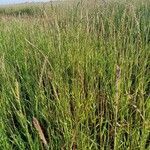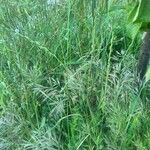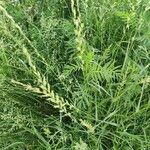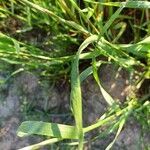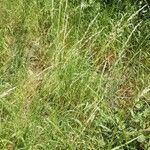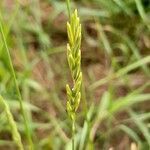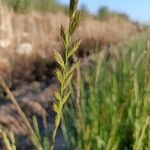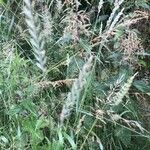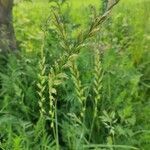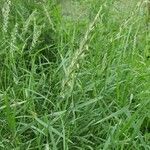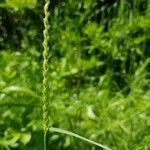Perennial. Culms 24–66 cm high, slender; mid-culm nodes not pigmented. Leaves: basal sheaths occasionally purple, becoming straw-coloured; auricles indistinct or absent; blade conduplicate in bud, 5.5–16 cm long, 2–4 mm wide. Spike 8–22.3 cm long, with 17–27 spikelets; axis slender, 0.9–1.7 mm wide, with angles smooth or scabrous. Spikelets 7–15 mm long, 1–7 mm wide, with 6–10 (–12) bisexual florets; rachilla segments 1–1.7 mm long. Glume diverging from spikelet, usually 1/2–3/4 length of spikelet, slightly longer than basal lemma; upper glume narrowly oblong or narrowly ovate or narrowly elliptic, 5–12 mm long, 3–7-nerved. Lemma laterally compressed, 5–6.8 mm long, awnless, membranous, 5-nerved, rarely slightly pigmented. Caryopsis oblong, not grooved or with a wide trough, 3.8–4 mm long, 1–1.3 mm wide.
Perennial, turf-forming. Culms tufted, erect or spreading, sometimes prostrate and rooting from lower nodes, 30–90 cm tall, 3–4-noded. Leaf blades soft, 5–20 cm × 3–6 mm, glabrous, young blades folded; auricles to 3 mm; ligule 2–2.5 mm. Raceme stiffly erect, or rarely slightly curved, 10–30 cm; rachis glabrous, smooth, spikelets usually less than their own length apart. Spikelets 0.8–2 cm, florets 5–10, rachilla internodes ca. 1 mm, smooth, glabrous; glume lanceolate, 1/3 as long to subequaling spikelet, 3–9-veined, margins narrowly membranous, apex acute or obtuse; lemmas oblong, herbaceous, 5–9 mm, 5-veined, smooth, apex obtuse to subacute, awnless; palea ciliolate along keels. Caryopsis length more than 3 times width. Fl. and fr. May–Jul. 2n = 14, 28.
Tufted perennial, 250-500(-900) mm high. Leaf blade 50-140(-300) x 2-4 mm, flat, folded along midrib when young; ligule an unfringed membrane. Inflorescence a spike with spikelets sunk and lying edgeways in partial cavities on alternate sides of central axis. Spikelet 10-15 x 3-10 mm; lower glume present only in terminal spikelet, similar to upper glume; upper glume ascending or spreading, 1/2-3/4 as long as spikelet, persistent. Florets 6-10; lemma acute, > 3x as long as wide, not turgid at maturity, awnless; palea as long as lemma, with 2 minutely rough keels; anther 2.9-4.0 mm long. Flowering time Mar., Apr., Nov., Dec. Caryopsis when mature > 3x as long as wide.
Tufted perennial 250-500(-900) mm high; culms numerous. Leaf blade 50-140(-300) x 2-4 mm, flat, folded along midrib when young. Spikelet 10-15 x 3-10 mm, usually 6-10-flowered; lower glume present only in a terminal spikelet, similar to upper glume; upper glume ascending or spreading, 1/2-3/4 as long as spikelet, not concealing the spikelet, persistent; lemma acute, more than 3 x as long as wide, not turgid at maturity, awnless; palea as long as lemma, with 2 minutely rough keels; anther 2.9-4.0 mm long; mature caryopsis more than three times as long as wide.
Mostly short-lived perennial; culms slender, 3–9(–12) dm; spike slender, 1–2 dm, the rachis scabrous on the margins and sometimes also on the back; spikelets (2–)5–22-fld; glume 4–12 mm, herbaceous, distinctly shorter than the spikelet; lemmas awned or awnless, the lowest 5–8 mm, the upper progressively reduced; 2n=14, 28. Native of Europe, cult. in meadows and lawns and often escaped onto roadsides and in waste places throughout our range and w. to the Pacific. Two well marked but wholly intergradient vars., apparently originating as agronomic strains.
Perennial; up to 0.5 m high; tufted; with many culms and sterile leafy shoots. Leaf blades 50-140(-300) x 2-4 mm; leaves flat; folded along midrib when young. Flowers: panicle a single; flat spike; spikelets 10-15 x 3-10 mm; glumes ascending or spreading; not concealing spikelets; 1/2-3/4 spikelet length; lemmas acute; not turgid at maturity; not awned; mature caryopsis > 3 x as long as wide.
Perennial, tufted (with numerous culms and sterile leafy shoots), up to 500 mm tall. Leaf blades 50-140 (-300) mm long, 2-4 mm wide. Spikelets 10-15 mm long, 3-10 mm wide. Glumes ascending or spreading, not concealing spikelets, half to three-quarters the spikelet length; lemmas acute, not turgid at maturity, awnless. Mature caryopsis more than 3 times as long as wide.
A grass which keeps growing from year to year. It grows 90 cm high. It produces both flowering and non flowering shoots. The base of the leaf sheaths is green or purplish. The midrib is easy to see. The leaf blade is usually 1 cm long by 2-4 mm wide. The lower surface is dark green and shiny. The flowers are in slightly curved spikes. These can be 15 cm long.
Superior glume shorter than the rest of the spikelet, 5-7-nerved, narrowly lanceolate to oblong-lanceolate, with the apex usually obtuse, smooth.
Perennial to 50 cm, with sterile shoots. Leaves linear. Spikelets in a simple spike, 10-15 x 3-10 mm, awnless.
Lemmas 5-7 mm. long, 5-nerved, muticous, imbricate, ovate-oblong or oblong, apex acute to sub-obtuse.
Spikelets 7-20 mm. long, 4-14-flowered, elliptic to obovate-elliptic in lateral view.
A caespitose perennial. Similar in habit to the preceding species.
Spikes 4-30 cm. long, stiff, slender to somewhat stout.
Leaf-laminae 3-20 cm. x 0·2-0·6 mm.
Paleas with the keels scaberulous.
Caryopsis c. 4·5 mm. long.
Anthers 3-4 mm. long.
